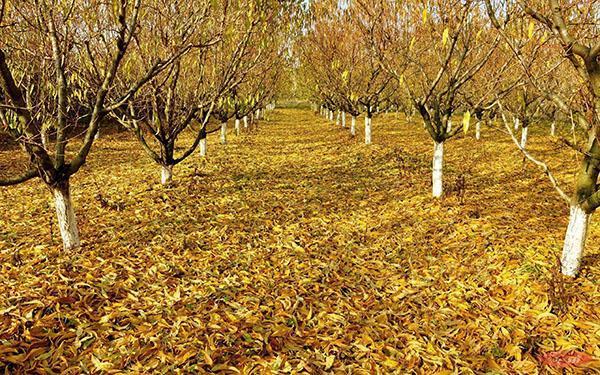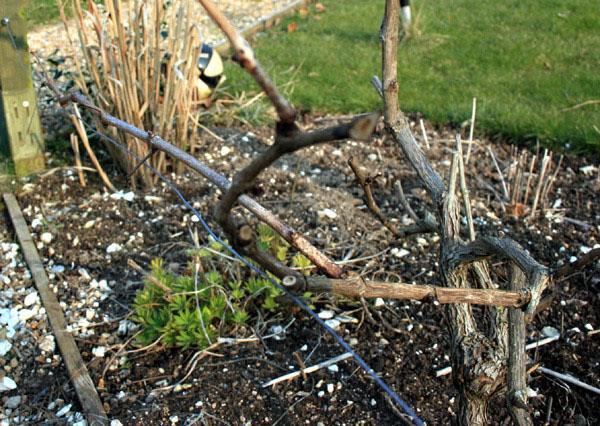Summer resident's calendar November: gardening
 Harvesting is long over, the fall of leaves has ceased, and the summer cottage garden is preparing for the onset of a long period of dormancy. In order for the fruit trees and shrubs to enter next spring well rested, strong and healthy, in November the summer resident will have to work hard.
Harvesting is long over, the fall of leaves has ceased, and the summer cottage garden is preparing for the onset of a long period of dormancy. In order for the fruit trees and shrubs to enter next spring well rested, strong and healthy, in November the summer resident will have to work hard.
November care of trees and shrubs in the garden

- branches affected by lichens, pests;
- broken or dried shoots;
- places of accumulation of insects that have already gathered comfortably for the winter.
In late autumn, the summer resident has a great opportunity to improve the garden by removing everything that can cause many problems next year. Dry twigs and sawn branches with traces of settled insects are burned. In the garden, especially from under the crowns, fallen leaves are carefully and carefully collected, becoming a refuge for pathogenic fungi and all kinds of pests. They are also sent to the fire.
The trunks of mature trees, if this work has not been done before, are whitewashed. Trunk circles under trees are densely covered with peat, needles, straw, sawdust.
 Seedlings that have entered the garden only this year have a very delicate bark and may suffer from sunburn. Therefore, it is better not to whiten them, but to cover them with special covers, coniferous spruce branches or wrap them in a dense non-woven material, having previously tied up and pulled the side shoots to the main conductor. This will prevent crown breaks during snowfalls, protect from frost, treacherous spring sun and rodents.
Seedlings that have entered the garden only this year have a very delicate bark and may suffer from sunburn. Therefore, it is better not to whiten them, but to cover them with special covers, coniferous spruce branches or wrap them in a dense non-woven material, having previously tied up and pulled the side shoots to the main conductor. This will prevent crown breaks during snowfalls, protect from frost, treacherous spring sun and rodents.
We must not forget about the shrubs. In November, it is still possible to trench and cover grapes, blackberries, and some thermophilic raspberries.
How to contain and use snow in the garden
 The first snow falling in late autumn is short-lived. Most often, it melts quickly, but if you cover the trunks with it, even a small feather bed will help protect the bases of the bushes, grafting sites on seedlings, adult trees from damage and cracking of the bark from soil frosts. A snow blanket will complement the layer of humus, peat, compost.
The first snow falling in late autumn is short-lived. Most often, it melts quickly, but if you cover the trunks with it, even a small feather bed will help protect the bases of the bushes, grafting sites on seedlings, adult trees from damage and cracking of the bark from soil frosts. A snow blanket will complement the layer of humus, peat, compost.
Strawberry beds are worth checking out in November. After the rains, the earth is compacted, part of the foliage wilts. They become well visible, especially on plantations transplanted in autumn, raised above the soil, bare plant bases. In order not to face the freezing of the berry crop next year, the beds are sprinkled tightly with peat, straw or ordinary soil mixed with rotted compost.
Throughout the garden, it is useful to place shields to trap snow and protect young plants from breakage. If such designs were not prepared in advance, do not despair. Stopping the cold air rampant and accumulating as much snow as possible will help the branches folded in the path of the wind. Even in mild, snowless winters, snowdrifts will grow near man-made barriers. Snow from them is easy to throw under the crowns in order to protect the garden plantings.
Harvesting cuttings of garden crops

Autumn pruning - a convenient time for harvesting healthy annual shoots for future grafting. Fruit trees store many nutrients by winter. They will help the cuttings to winter well and take root in the spring in a new place.
In November, apple, pear, cherry and other types of stone fruit are cuttings. If the autumn is warm, and the foliage has fallen recently, it is not too late to cut the shanks grapes for spring planting.
Planting material is harvested on a dry, relatively warm day, when the cut shoots cannot freeze. The cuttings are divided into varieties, collected in bunches, tied and wrapped in foil. In this form, the planting material will remain until spring in an ordinary basement or in special trenches about half a meter deep. The bottom is densely lined with sand, and then laid bundles of cuttings are covered with soil, straw, foliage. A shelter made of moisture-proof material is made on top.
Arrangement of feeders and protection from rodents in the garden
 The garden has traditionally attracted many pests. In winter, it is a favorite habitat for rodents. Suburban areas are visited by hares attracted by the succulent bark of fruit plants. Mice settle at the roots, using a layer of mulch, leaves, straw and snow as a warm home and excellent food source.
The garden has traditionally attracted many pests. In winter, it is a favorite habitat for rodents. Suburban areas are visited by hares attracted by the succulent bark of fruit plants. Mice settle at the roots, using a layer of mulch, leaves, straw and snow as a warm home and excellent food source.
A reliable fence will protect the planting from the raids of eared pests. Fighting mice is much more difficult. In November, the garden is thoroughly cleaned of dead plants, foliage and other debris. Then move on to personal tree protection. Their trunks are wrapped and tightly, slightly below ground level, tied with newsprint, strips of roofing material, dense covering material or geotextile. Then the base of the trunk is sprinkled with earth, and under a layer of mulch, straw or other insulation, poisoned bait for rodents is scattered.
You can prevent the dispersal of insects in the spring in the fall by hanging birds around the garden feeders... For them, they choose quiet, wind-protected corners and are regularly replenished. Having got used to delicious feeding during the winter, the birds will certainly fly here with the onset of warmth to clear the trees of waking up beetles, aphids and other uninvited guests.